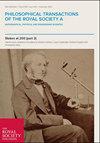Physical conditions of protosolar matter
Philosophical Transactions of the Royal Society of London. Series A, Mathematical and Physical Sciences
Pub Date : 2001-10-15
DOI:10.1098/rsta.2001.0896
引用次数: 4
Abstract
I review a few astronomical constraints concerning physical conditions in and evolutionary time–scales of protoplanetary discs. Some revisions are suggested to the scenario by which short–lived radioactive species would enter the protosolar cloud. The increasing evidence for substantial grain growth in discs at ages of 1 Myr is also outlined. Protoplanetary discs are accretion discs; when (inner) dust emission decreases strongly, accretion stops, demonstrating a relationship between the disappearance of infrared excess emission and accretable gas. The time–scale for disc ‘clearing’ is ca. 3–10 Myr, with a large range for individual systems. If disc masses estimated from dust emission are at all accurate, then the amount of material accreted onto the central star during the T Tauri phase is a substantial fraction of the total disc mass available at 1 Myr; and this in turn implies substantial radial motion of the accreting material during disc evolution. It may be that the formation of planets is the primary mechanism resulting in the cessation of accretion; certainly it is difficult to see how gas can be removed from T Tauri discs on 10 Myr time–scales.原太阳物质的物理条件
我回顾了一些关于原行星盘的物理条件和演化时间尺度的天文限制。对短期放射性物质进入原太阳云的设想提出了一些修正。还概述了越来越多的证据表明,在1 Myr年龄的圆盘中有大量的晶粒生长。原行星盘是吸积盘;当(内部)尘埃发射强烈减少时,吸积停止,表明红外过量发射的消失与可吸积气体之间的关系。圆盘“清理”的时间尺度约为3-10迈尔,个别系统的范围很大。如果从尘埃发射中估计的盘质量是准确的,那么在金牛座T星阶段吸积到中央恒星上的物质数量是1 Myr可用盘总质量的很大一部分;这反过来意味着吸积物质在盘的演化过程中进行了大量的径向运动。行星的形成可能是导致吸积停止的主要机制;当然,很难看到气体如何在10迈里的时间尺度上从金牛座的圆盘上移除。
本文章由计算机程序翻译,如有差异,请以英文原文为准。
求助全文
约1分钟内获得全文
求助全文
来源期刊
自引率
0.00%
发文量
0

 求助内容:
求助内容: 应助结果提醒方式:
应助结果提醒方式:


